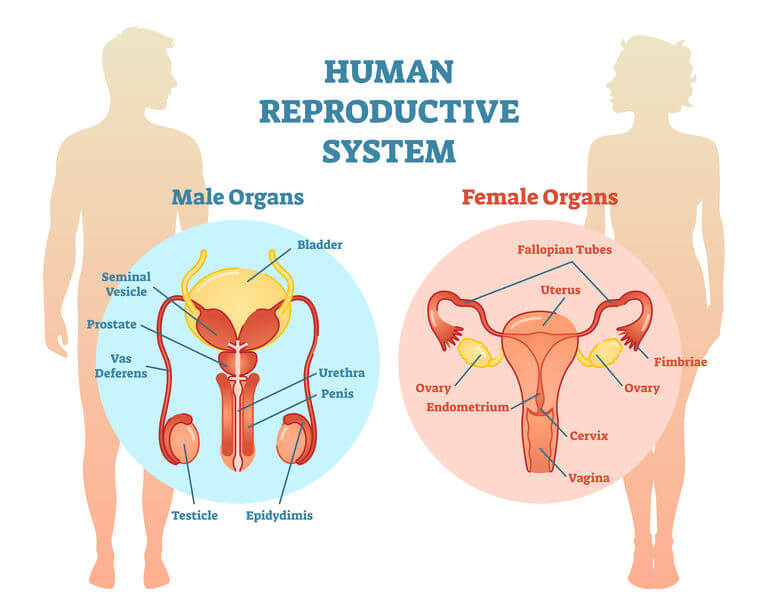Reproduction
Once girls and boys reach puberty, their bodies become physically able to conceive and give birth to a baby. From this point onwards, if a boy and girl have sex, it is possible that the girl could become pregnant. This is known as ‘reproduction’.
Take a look at the diagram below, showing the structure of the male and female reproductive systems.

Now click through the slide panel below to find out how these systems work together to make a baby.
Pregnancy is divided into three periods of time, known as trimesters. The first trimester runs from week 1 to week 12, the second trimester is week 13 to week 27 and the third and final trimester is week 28 to week 40.
You can click on the timeline below to learn more about some of the key stages of a baby’s development during a pregnancy.
4 weeks
After 4 weeks, the baby is the size of a grain of rice (around 2mm long). It is visible to the naked eye. The brain and spinal cord are starting to form.
8 weeks
The eyes and ears are growing, and the baby is about 2cm long, from the crown (top) of its head to its bottom. At this stage, the head is much larger than the body. The baby’s face is developing, the bones in the arms and legs start to harden, and elbows, knees, fingers and toes can be seen.
12 weeks
By week 12, the baby is fully formed but still only about 5cm long. It has ears, toes, fingers, fingernails, and either male or female external genitals can now be seen.
At some point between 8 and 14 weeks, the mother will be offered a ‘dating scan’ – this is an ultrasound scan, where a sonographer will scan the tummy to see a detailed picture of the baby inside the womb. This scan will check that all is well with the baby (or the scan may show that there is more than one baby growing in the womb)! Based on measurements taken during the scan, the mother will be given a date when the baby (or babies) are due to be born.
20 weeks
The baby is now around 18cm long – this is half as long as it will be when it is born. The legs are in proportion with the rest of the body, fingernails are well developed and faint eyebrows are visible. The baby will become more active in the womb now – kicking, punching and turning around. Even though the baby has been active for some time, the mother may not be able to feel these movements until around 18 to 20 weeks into the pregnancy. At this stage, the mother may start to feel a bubbling or fluttering sensation in their stomach, which could be the first feelings of their baby moving around. These feelings will become more obvious and pronounced as the pregnancy progresses and the baby’s movements become stronger.
At around 18 to 20 weeks, the mother will have the opportunity to have an ultrasound scan which looks at the baby in detail to see if there is anything unusual about the baby’s development or appearance. During this scan, the sex of the baby may be determined…but it’s not always possible to see, depending on the position and movement of the baby.
30 weeks
By this stage, the baby’s organs are all fully formed and its sense of hearing is also well developed – it will respond to noise outside the womb. The baby may now have hair on its head and, when the baby is awake, it will open its eyes.
38 weeks
In the last few weeks of pregnancy (some time between 36 and 40 weeks), the baby’s head will engage (this means it is positioned just at the top of the mother’s cervix, ready to be born).
Did you know?
- If two ova (eggs) leave the ovaries at the same time and they are both fertilised, then 'non-identical' twins are born. They may look alike or they may not, just like any brothers or sisters.
- If an ovum splits after it has been fertilised, then you get identical twins because they have the same set of genes – they are growing from the same egg.

